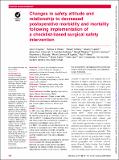| dc.contributor.author | Haynes, A. B. | |
| dc.contributor.author | Weiser, T. G. | |
| dc.contributor.author | Berry, W. R. | |
| dc.contributor.author | Lipsitz, S. R. | |
| dc.contributor.author | Breizat, A.-H. S. | |
| dc.contributor.author | Dellinger, E. P. | |
| dc.contributor.author | Dziekan, G. | |
| dc.contributor.author | Herbosa, T. | |
| dc.contributor.author | Kibatala, P. L. | |
| dc.contributor.author | Lapitan, M. C. M. | |
| dc.contributor.author | Merry, A. F. | |
| dc.contributor.author | Reznick, R. K. | |
| dc.contributor.author | Taylor, B. | |
| dc.contributor.author | Vats, A. | |
| dc.contributor.author | Gawande, A. A. | |
| dc.date.accessioned | 2019-03-29T10:33:04Z | |
| dc.date.issued | 2011 | |
| dc.identifier.citation | Haynes, A. B., T. G. Weiser, W. R. Berry, S. R. Lipsitz, A.-H. S. Breizat, E. P. Dellinger, G. Dziekan, et al. 2011. “Changes in Safety Attitude and Relationship to Decreased Postoperative Morbidity and Mortality Following Implementation of a Checklist-Based Surgical Safety Intervention.” BMJ Quality & Safety 20 (1): 102–7. https://doi.org/10.1136/bmjqs.2009.040022. | |
| dc.identifier.issn | 2044-5415 | |
| dc.identifier.issn | 2044-5423 | |
| dc.identifier.uri | http://nrs.harvard.edu/urn-3:HUL.InstRepos:38846197 | * |
| dc.description.abstract | Objectives: To assess the relationship between changes in clinician attitude and changes in postoperative outcomes following a checklist-based surgical safety intervention.Design: Pre- and post intervention survey.Setting: Eight hospitals participating in a trial of a WHO surgical safety checklist.Participants: Clinicians actively working in the designated study operating rooms at the eight hospitals.Survey instrument: Modified operating-room version Safety Attitudes Questionnaire (SAQ).Main outcome measures: Change in mean safety attitude score and correlation between change in safety attitude score and change in postoperative outcomes, plus clinician opinion of checklist efficacy and usability.Results: Clinicians in the preintervention phase (n=281) had a mean SAQ score of 3.91 (on a scale of 1 to 5, with 5 representing better safety attitude), while the postintervention group (n=257) had a mean of 4.01 (p=0.0127). The degree of improvement in mean SAQ score at each site correlated with a reduction in postoperative complication rate (r-0.7143, p=0.0381). The checklist was considered easy to use by 80.2% of respondents, while 19.8% felt that it took a long time to complete, and 78.6% felt that the programme prevented errors. Overall, 93.4% would want the checklist used if they were undergoing operation.Conclusions: Improvements in postoperative outcomes were associated with improved perception of teamwork and safety climate among respondents, suggesting that changes in these may be partially responsible for the effect of the checklist. Clinicians held the checklist in high regard and the overwhelming majority would want it used if they were undergoing surgery themselves. | |
| dc.language.iso | en_US | |
| dash.license | META_ONLY | |
| dc.title | Changes in Safety Attitude and Relationship to Decreased Postoperative Morbidity and Mortality Following Implementation of a Checklist-based Surgical Safety Intervention | |
| dc.type | Journal Article | |
| dc.description.version | Version of Record | |
| dc.relation.journal | BMJ Quality & Safety | |
| dash.depositing.author | Gawande, Atul Atmaram::3861be84cf2aae828a65939fc165d5c0::600 | |
| dc.date.available | 2019-03-29T10:33:04Z | |
| dash.workflow.comments | 1Science Serial ID 13624 | |
| dc.identifier.doi | 10.1136/bmjqs.2009.040022 | |
| dash.source.volume | 20;1 | |
| dash.source.page | 102-107 | |


